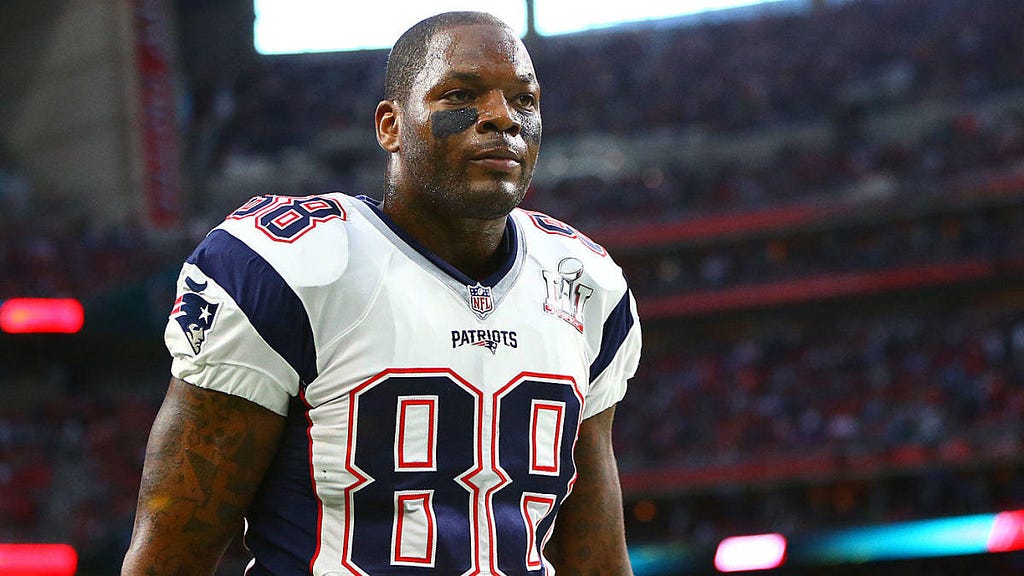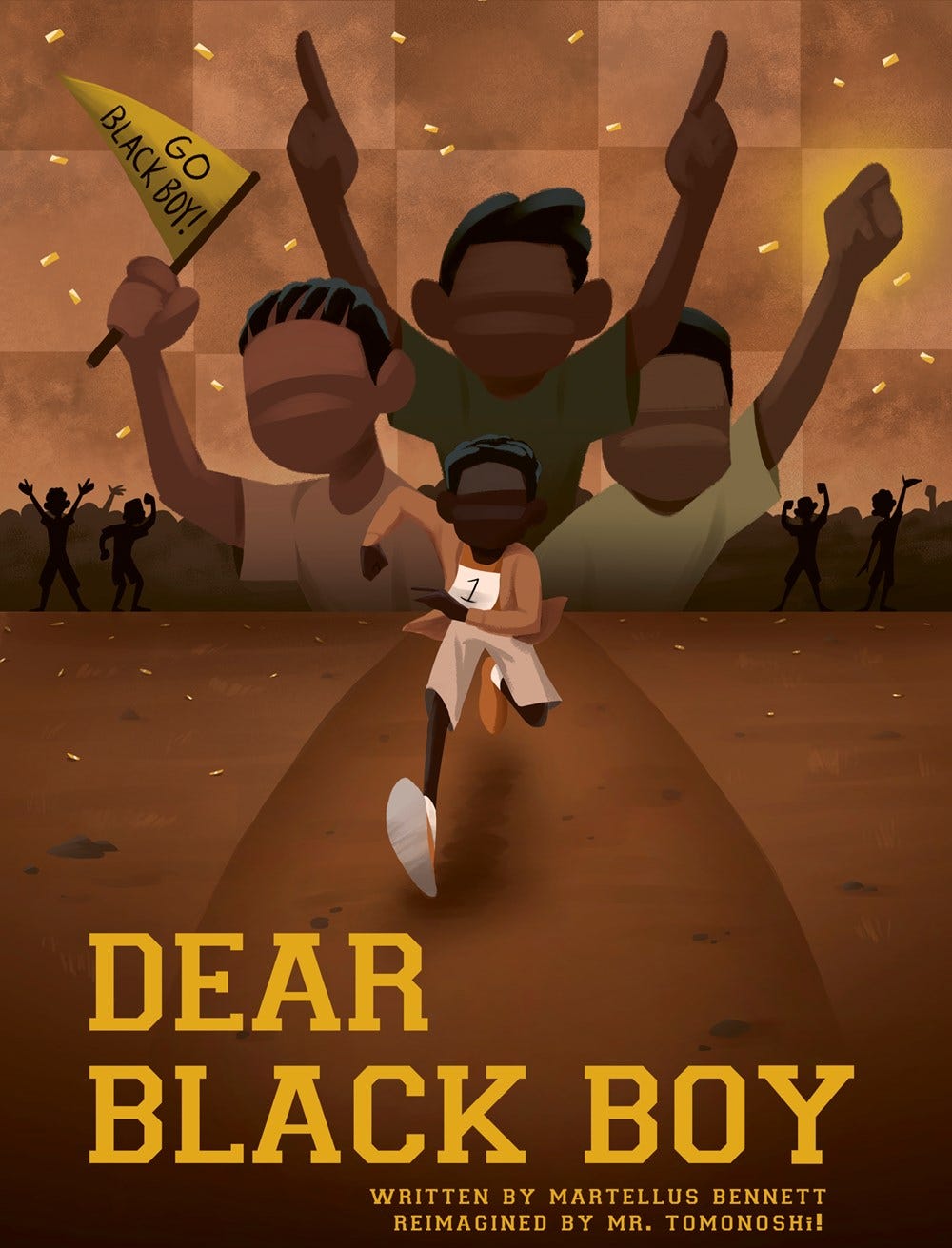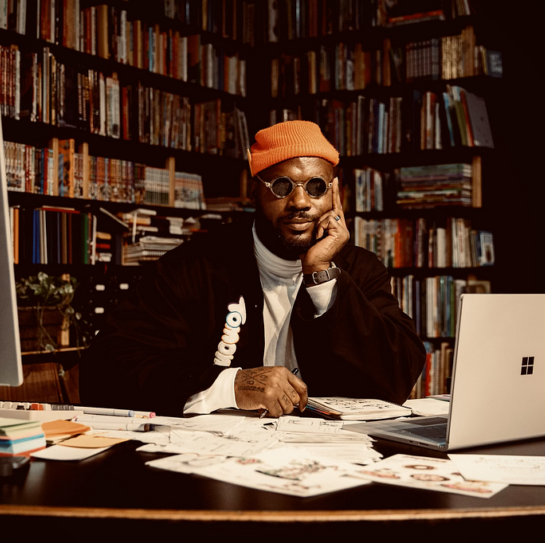In the world of professional sports, many athletes struggle to find a new purpose once their playing days are over. But for Martellus Bennett, football was never the endgame — it was a stepping stone. A Super Bowl champion turned entrepreneur, Bennett is a writer, animator, film director, educator, political cartoonist, game designer, and architect of imagination. His mission? To liberate the Black imagination and create new worlds where creativity knows no bounds. Even while playing in the NFL, he was making moves — writing books, producing animated films, and designing toys. His transition wasn’t an afterthought; it was a carefully constructed bridge. In this interview, he takes us through that journey, his philosophy on leadership, and how he filters through the noise of modern distractions to stay true to his creative vision.
Martellus Bennett is a maker and master world builder who has dedicated his life to the liberation of the Black imagination. The Super Bowl Champion’s creativity knows no boundaries. As a writer, animator, film director, educator, political cartoonist, game designer, and architect, his dedication to his craftsmanship is a testimony to the magnificent possibilities of the Black imagination when it works outside of the constructs of societal beliefs. Working under the moniker MR. TOMONOSHi! he continues to prove that the world is beautiful when the Black Boy dreams and that with the right preparation and empowered imagination every Black Boy can win.
Thank you for taking the time to speak with me. Let’s start with your journey. Many athletes struggle with transitioning from sports to entrepreneurship. What inspired you to make this leap?
I was actually doing entrepreneurial things while I was playing. I started my companies while I was still in the NFL. I was writing books, making movies — I knew I had to build a bridge before I needed to cross it. As an athlete, you train for about four or five hours a day in the off-season, but then what? You have the rest of the day to do something with. I always saw myself as a maker, so I spent that time figuring out what I wanted to create — whether it was food, books, toys, or games. Over time, I found what I loved and just kept making those things.
Tell us about some of the things you were creating while you were playing.
When I was with the Dallas Cowboys, I was doing art exhibitions and performing music. Then, when I got to the New York Giants, I ended up saving someone’s life in the stadium — literally caught a guy falling 25 feet from the stands. That story led me to animation because I wanted to tell it visually. By the time I was with the Chicago Bears, I had my daughter, and I started writing children’s books, developing interactive apps, and producing my first animated film.
That’s incredible. Take me back to your childhood and how football became part of your journey?
I grew up in Houston, Texas, where football is almost like a religion. But for me, it wasn’t a conscious decision — it was just what we did in the neighborhood. We played everything — football, basketball, tennis — whatever was in season. It wasn’t like today, where kids are put into one sport and told to specialize. We organized our own games, knocked on each other’s doors, and challenged kids from other neighborhoods to prove we were the best. It wasn’t until middle or high school that I realized I had something special.
You were one of the top high school athletes in the country. What was your biggest memory from that time?
I was actually working out for NBA teams while in high school. I was the number one football and basketball player in Texas. One of my favorite memories was flying to work out for the Memphis Grizzlies and then coming back to school the next day in full Memphis gear. That was a cool moment.

What was it like transitioning from college to the NFL, especially when you received your first big paycheck?
It’s all about understanding money and knowing what you believe about it. Depending on where you grow up, money is either a tool to buy tools or a constant problem. I was kind of in the middle — I had a Corvette with a drop-top, but most of my money went into manufacturing my imagination. The biggest lessons I learned weren’t about the cost of making a product but about investing in the right people. You don’t always know who to trust when you’re young and suddenly have money, and that only comes with experience.
You’ve worked with a variety of leaders in the NFL and now in business. What defines great leadership in your eyes?
I learned a lot from my time in the NFL. Leadership isn’t just about being the loudest voice in the room — it’s about clear communication, setting expectations, and empowering people to do their jobs. Bill Belichick was one of the best leaders I’ve seen. He was honest, straightforward, and never beat around the bush. He told you what he expected and let you figure out the best way to get it done. Leadership isn’t about friendship — it’s about clarity, vision, and consistency.
What lessons did you take from your time in the NFL that still influence your approach to life and creativity today?
Football was never just football to me. It was always a stepping stone. The NFL taught me how to prepare, how to work within a team, how to push through when things get tough. People think the game is won on Sunday, but it’s really won in the hours nobody sees — watching film, practicing, refining every little detail. That’s how I approach creativity. You don’t just show up and create magic; you put in the work every single day. The same discipline I had in football is the same discipline I apply to writing, directing, designing — everything. I treat creativity like a sport. You train your imagination like a muscle. The more you use it, the stronger it gets.
Your work is deeply tied to identity — How has your journey shaped the way you see yourself and the stories you choose to tell?
Identity is fluid, but the world wants to make it static. They want to label you — ‘football player,’ ‘entrepreneur,’ ‘artist’ — as if you can only be one thing. But I’ve never believed in that. I’ve always seen myself as a creator first. Football was just something I did, not who I was. The problem is, when you let the world define you, you start shrinking yourself to fit inside their definition. I refuse to do that. That’s why my work is so focused on expanding the Black imagination — because when we control our own narratives, we control our own identities.
You’ve spoken about the power of perspective — how changing the way you see the world can change your life. Can you expand on that?
Everything starts in the mind. The way you see the world determines how you move through it. If you believe the world is small, your dreams will be small. If you think there’s only one path, you won’t look for another way. But the moment you shift your perspective, the world opens up. I’ve always believed in possibility. I don’t see obstacles — I see puzzles. And puzzles have solutions. That mindset has allowed me to move from football to storytelling, to animation, to education. When you change how you see things, you realize you’re not stuck. You’re just looking at the problem from the wrong angle.
With AI, remote work, and constant digital distractions, how do you decide what to focus on?
I believe the most intelligent people aren’t the ones who hold the most knowledge in their heads, but the ones who know where to find the right information when they need it. But here’s the thing — computers don’t have taste. Templates make everything look the same. Your visual identity and creative perspective are more important than ever. I prioritize writing and drawing because those are the systems that feed my creativity. Technology is just a tool — my real work starts on paper.
You coined the term Tomanoshi. What does it mean?
It came from a trip to Japan after I retired. I met a woman named Miho, who loved her job as a tour guide. She took 30,000 steps a day, and she loved every single one. That made me realize I didn’t love everything about football. I wanted what Miho had — so I created Tomanoshi as a philosophy of living with joy in creation. For me, a life of making is Tomanoshi.
What’s next for you? What needs to happen in the next year for you to feel successful?
My main focus is launching my new mobile game. I want to pour all my intelligence and creativity into one product that ties together everything I do — games, books, music, and storytelling. I also need to build a better mailing list, not just for product updates but to share my thoughts, my vision, and why I do what I do. Social media reach is unpredictable, but email allows me to connect directly with my audience.
You talk a lot about liberating the Black imagination. Can you expand on what that means?
When I say liberating the Black imagination, I mean creating without any constraints. So many creators often have to mold their work to fit mainstream expectations. I want to create worlds that fully reflect our stories and experiences without compromise. But that doesn’t mean my work is only for Black people — I want everyone to experience these worlds, just like we all grew up watching white stories. The goal is to scale Black imagination on a global level.
Where can people find you and learn more about your work?
You can find me on social media and sign up for my mailing list to stay up to date with what I’m working on.
- Instagram: @martellusb
- X (formerly Twitter): @MartysaurusRex
- Facebook: Martellus Bennett Official
- Website: The Imagination Agency
Martellus Bennett is a force of creativity, using his imagination to reshape the landscape of storytelling, play, and entrepreneurship. As he continues to build new worlds, one thing is clear: he’s just getting started.

A different kind of coach for black and brown boys, and essential reading for children of every color, Dear Black Boy empowers kids to see new possibilities and follow their passions. Whenever self-doubt creeps in, they will find strength in its pages. With dreamlike illustrations that invite children to place themselves in the pages’ scenes, this uplifting picture book reminds kids that the biggest game they’ll ever play is the game of life. Off the courts and fields, people are rooting for them not as athletes, but as future leaders of the world.
“The captivating images in this wonderful new edition of Martellus Bennett’s Dear Black Boy further highlight his inspirational message of individual and collective struggle — through sports disciplines and through social justice movements. Children, regardless of their gender, are sure to love and to learn from this beautiful book.”
— Angela Davis, Political Activist, Educator, Author
“A great book for boys to read for the first time with an amazing mission. Written with amazing intentions for a futuristic direction.”
— Chuck Inglish, Producer, designer, artist, actor, and chef
“In every Black boy’s heart, a world of untamed imagination awaits. Dear Black Boy is a celebration of that boundless creativity. Let this story remind you that within each of us lies the power to turn dreams into reality, transforming our most difficult days into unlimited possibilities and true freedom.”
— Carl Jones, Producer of The Boondocks/Black Dynamite, animation writer, director
“Dear Black Boy allows Black men to tap into their boyhood at its essence. It serves as a guide that allows us to explore every side that we’ve been told we don’t possess. Working in education, representation, and imagination means everything. I think there is something for everyone to experience in Dear Black Boy.”
— Jarren Small, Co-founder and CEO of Reading with a Rapper
“Dear Black Boy is a clarion call for resilience and imagination, urging Black boys everywhere to confront their challenges, embrace their identities, and envision a future where they define their own destinies.”
— Michael Bennett, Super Bowl Champion, pro bowler, and architect
“This powerful book encourages young Black boys to prepare their minds, bodies, and skills to achieve the unimaginable. It’s a heartfelt guide that champions passion and conviction, empowering them to lead with strength and purpose. Dear Black Boy is not just a book; it’s a movement for every Black boy to embrace their potential and rise to greatness.”
— Jason Mayden, Chief Design Officer, Jordan Brand
“I wish someone could have provided this information to me when I was young. For men like me reading this now, I suggest you take its message to heart.”
— Serigne Mbaye, James Beard Award Winner, chef, and owner of Dakar NOLA Restaurant
“Martellus Bennett pens a story for dreamers. He inspires Black boys to aspire to more, work harder, and manifest a life they were once told they couldn’t achieve. Dear Black Boy is a WIN for us all.”
— Ryan Clark, 44th Annual Sports Emmy Awards Winner, sports broadcaster, Super Bowl Champion, and pro bowler
“I believe every Black boy in America should have this book as part of their curriculum from K through 12. It’s monuMINTal.”
— Tobe Nwigwe, Rapper, singer, actor
“Dear Black Boy is a piece of ART needed more now than ever. We’re often confronted with finite ways we can dream and be successful. This book widens that view. These words breathe possibility, responsibility, and HOPE!”
— Frank E. Abney III, Writer, director. and animator
